| Pericardiocentesis | |
|---|---|
 | |
| ICD-9-CM | 37.0 |
| MeSH | D020519 |
| MedlinePlus | 003872 |
Pericardiocentesis (PCC), also called pericardial tap, is a medical procedure where fluid is aspirated from the pericardium (the sac enveloping the heart).
| Pericardiocentesis | |
|---|---|
 | |
| ICD-9-CM | 37.0 |
| MeSH | D020519 |
| MedlinePlus | 003872 |
Pericardiocentesis (PCC), also called pericardial tap, is a medical procedure where fluid is aspirated from the pericardium (the sac enveloping the heart).
The pericardium is a fibrous sac surrounding the heart composed of two layers: an inner visceral pericardium and an outer parietal pericardium. [1] The area between these two layers is known as the pericardial space and normally contains 15 to 50 mL of serous fluid. [2] This fluid protects the heart by serving as a shock absorber and provides lubrication to the heart during contraction. [1] [2]
The elastic nature of the pericardium allows it to accommodate a small amount of extra fluid, roughly 80 to 120 mL, in the acute setting. [2] However, once a critical volume is reached, even small amounts of extra fluid can rapidly increase pressure within the pericardium. This pressure can significantly hinder the ability of the heart to contract, leading to cardiac tamponade. If accumulation of fluid is slow and occurs over weeks to months, the pericardial sac can tolerate several liters of additional fluid without substantially hindering the ability of the heart to pump. [2]
Indications for performing pericardiocentesis can be divided into those that are therapeutic (i.e. treating tamponade) and those that are diagnostic (i.e. pericardial fluid analysis). [2]
Pericardiocentesis can be used to diagnose and treat cardiac tamponade. [3] [4] Cardiac tamponade is a medical emergency in which excessive accumulation of fluid within the pericardium (pericardial effusion) creates increased pressure. [5] This prevents the heart from filling normally with blood. This can critically decrease the amount of blood that is pumped from the heart, causing obstructive shock, which can be lethal. The removal of the excess fluid reverses this dangerous process, and is often the first treatment for cardiac tamponade due to its speed. [5]
Pericardiocentesis can relieve the symptoms of pericarditis. [3] [4] There may be a normal amount of pericardial fluid, but inflammation still causes compression of the heart. Removal of some of this fluid reduces pressure on the heart.[ citation needed ]
Pericardiocentesis can also be used to analyze the fluid surrounding the heart. [3] [4] Fluid may be analyzed to differentiate a number of conditions, including:[ citation needed ]
There are no absolute contraindications to pericardiocentesis in emergency situations where a patient is hemodynamically unstable. [2] [6]
Pericardiocentesis is a one-off procedure, which may not be appropriate for long-term drainage. In cases where longer term drainage is needed, the cardiothoracic surgeon can create a pericardial window. This involves the removal of a section of the pericardium, and the placement of a chest tube.[ citation needed ]
Pericardiocentesis is not appropriate if cardiac tamponade is associated with aortic dissection. [4] In this case, there is a high risk of the procedure worsening this aortic dissection by causing haemorrhage. [4]
Pericardiocentesis is not usually useful for diagnosis of more minor pericardial effusion. [3] [4]
Other relative contraindications include coagulopathies, thrombocytopenia, myocardial rupture, severe pulmonary hypertension, prior thoracoabdominal surgery, prosthetic heart valves, pacemakers and other cardiac devices, inadequate visualization of the effusion on ultrasound during the procedure, and situations in which more appropriate treatment options are available. [2] [6]
The patient undergoing pericardiocentesis is positioned supine with the head of the bed raised between a 30 and 60 degree angle. This places the heart in proximity to the chest wall for easier insertion of the needle into the pericardial sac. [5] [7] For patients that are awake, a local anaesthetic is applied. [8] A large needle is inserted through the skin of the chest into the pericardium, and the practitioner aspirates the pericardial effusion into a syringe. [6] If needed, a drain can be placed using the Seldinger technique for continuous access. [6]

There are multiple locations that pericardiocentesis can be performed without puncturing the lungs. [9]
Pericardiocentesis should be performed with ultrasound guidance whenever possible to prevent complications. [2] [6] This allows practitioners to assess the location of the pericardial effusion and identify adjacent structures. [6] With ultrasound guidance, an apical approach is most often used, but parasternal and subxiphoid approaches can also be used. Agitated saline is injected and visualized sonographically to confirm the needle placement in the pericardium. [6]
Pericardiocentesis can be performed using computed tomography (CT) imaging in cases of complex or loculated effusions or when ultrasound has failed to provide proper visualization. [6]
Blind pericardiocentesis can be performed in emergency settings when ultrasound is not available and typically utilizes a subxiphoid approach. [2] [6] As the needle is advanced, aspiration is performed to assess for advancement of the needle into the pericardial space. [6] To prevent perforation of the heart, electrocardiographic (ECG) monitoring might be used. This involves using an alligator clip to attach an ECG lead to the needle. Changes in ECG waves, such as ST segment elevations or PR depressions, are indicative of contact with the myocardium. [6]
Fewer than 1.5% of patients experience complications from pericardiocentesis. [11] The most common complications are lacerations of coronary arteries, and puncture of the left ventricle (with associated bleeding from both). [11] [12] Echocardiograms can help to identify complications. [12] Blind approaches are typically only advised in emergencies, and a guided approach is typically preferred (using echocardiography). [12] [8]

The pericardium, also called pericardial sac, is a double-walled sac containing the heart and the roots of the great vessels. It has two layers, an outer layer made of strong inelastic connective tissue, and an inner layer made of serous membrane. It encloses the pericardial cavity, which contains pericardial fluid, and defines the middle mediastinum. It separates the heart from interference of other structures, protects it against infection and blunt trauma, and lubricates the heart's movements.
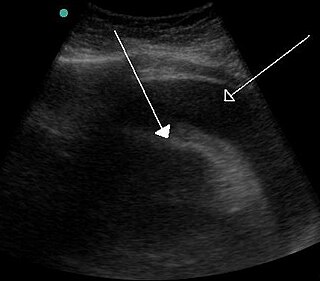
Cardiac tamponade, also known as pericardial tamponade, is a compression of the heart due to pericardial effusion. Onset may be rapid or gradual. Symptoms typically include those of obstructive shock including shortness of breath, weakness, lightheadedness, and cough. Other symptoms may relate to the underlying cause.

Aortic dissection (AD) occurs when an injury to the innermost layer of the aorta allows blood to flow between the layers of the aortic wall, forcing the layers apart. In most cases, this is associated with a sudden onset of severe chest or back pain, often described as "tearing" in character. Also, vomiting, sweating, and lightheadedness may occur. Other symptoms may result from decreased blood supply to other organs, such as stroke, lower extremity ischemia, or mesenteric ischemia. Aortic dissection can quickly lead to death from insufficient blood flow to the heart or complete rupture of the aorta.
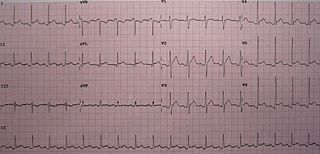
Pericarditis is inflammation of the pericardium, the fibrous sac surrounding the heart. Symptoms typically include sudden onset of sharp chest pain, which may also be felt in the shoulders, neck, or back. The pain is typically less severe when sitting up and more severe when lying down or breathing deeply. Other symptoms of pericarditis can include fever, weakness, palpitations, and shortness of breath. The onset of symptoms can occasionally be gradual rather than sudden.
Dressler syndrome is a secondary form of pericarditis that occurs in the setting of injury to the heart or the pericardium. It consists of fever, pleuritic pain, pericarditis and/or pericardial effusion.

The mediastinum is the central compartment of the thoracic cavity. Surrounded by loose connective tissue, it is an undelineated region that contains a group of structures within the thorax, namely the heart and its vessels, the esophagus, the trachea, the phrenic and cardiac nerves, the thoracic duct, the thymus and the lymph nodes of the central chest.

Tamponade is the closure or blockage by or as if by a tampon, especially to stop bleeding. Tamponade is a useful method of stopping a hemorrhage. This can be achieved by applying an absorbent dressing directly into a wound, thereby absorbing excess blood and creating a blockage, or by applying direct pressure with a hand or a tourniquet. There can, however, be serious consequences when a tamponade occurs as a result of health problems. For example: cardiac tamponade is a condition where fluid collects in the pericardial sac increasing pressure within the pericardium which in turn prevents the ventricles from expanding fully significantly reducing the efficiency of the heart. It is considered a medical emergency and if left unchecked is fatal.

A pericardial effusion is an abnormal accumulation of fluid in the pericardial cavity. The pericardium is a two-part membrane surrounding the heart: the outer fibrous connective membrane and an inner two-layered serous membrane. The two layers of the serous membrane enclose the pericardial cavity between them. This pericardial space contains a small amount of pericardial fluid. The fluid is normally 15-50 mL in volume. The pericardium, specifically the pericardial fluid provides lubrication, maintains the anatomic position of the heart in the chest, and also serves as a barrier to protect the heart from infection and inflammation in adjacent tissues and organs.
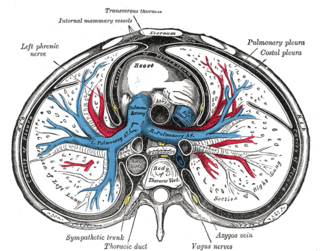
Pericardial fluid is the serous fluid secreted by the serous layer of the pericardium into the pericardial cavity. The pericardium consists of two layers, an outer fibrous layer and the inner serous layer. This serous layer has two membranes which enclose the pericardial cavity into which is secreted the pericardial fluid. The fluid is similar to the cerebrospinal fluid of the brain which also serves to cushion and allow some movement of the organ.

The pericardial sinuses are impressions in the pericardial sac formed between the points where great vessels enter it.

Acute pericarditis is a type of pericarditis usually lasting less than 6 weeks. It is the most common condition affecting the pericardium.

Electrical alternans is an electrocardiographic phenomenon of alternation of QRS complex amplitude or axis between beats and a possible wandering base-line. It is seen in cardiac tamponade and severe pericardial effusion and is thought to be related to changes in the ventricular electrical axis due to fluid in the pericardium, as the heart essentially wobbles in the fluid filled pericardial sac.
Pericardiectomy is the surgical removal of part or most of the pericardium. This operation is most commonly used to relieve constrictive pericarditis, or to remove a pericardium that is calcified and fibrous. It may also be used for severe or recurrent cases of pericardial effusion. Post-operative outcomes and mortality are significantly impacted by the disease it is used to treat.
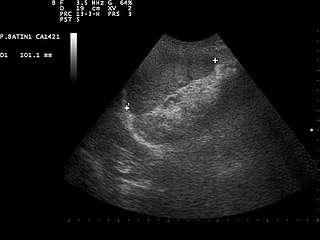
Focused assessment with sonography in trauma is a rapid bedside ultrasound examination performed by surgeons, emergency physicians, and paramedics as a screening test for blood around the heart or abdominal organs (hemoperitoneum) after trauma. There is also the extended FAST (eFAST) which includes some additional ultrasound views to assess for pneumothorax.
Emergency ultrasound employing point-of-care ultrasound (POCUS) is the application of ultrasound at the point of care to make immediate patient-care decisions. It is performed by the health care professional caring for the injured or ill persons. This point-of-care use of ultrasound is often to evaluate an emergency medical condition, in settings such as an emergency department, critical care unit, ambulance, or combat zone.
Obstructive shock is one of the four types of shock, caused by a physical obstruction in the flow of blood. Obstruction can occur at the level of the great vessels or the heart itself. Causes include pulmonary embolism, cardiac tamponade, and tension pneumothorax. These are all life-threatening. Symptoms may include shortness of breath, weakness, or altered mental status. Low blood pressure and tachycardia are often seen in shock. Other symptoms depend on the underlying cause.
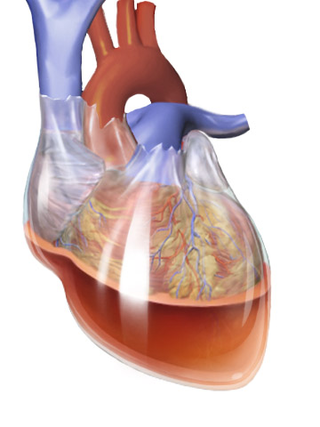
Hemopericardium refers to blood in the pericardial sac of the heart. It is clinically similar to a pericardial effusion, and, depending on the volume and rapidity with which it develops, may cause cardiac tamponade.
The Hs and Ts is a mnemonic used to aid in remembering the possible reversible causes of cardiac arrest. A variety of disease processes can lead to a cardiac arrest; however, they usually boil down to one or more of the "Hs and Ts".
A pericardial window is a cardiac surgical procedure to create a fistula – or "window" – from the pericardial space to the pleural cavity. The purpose of the window is to allow a pericardial effusion or cardiac tamponade to drain from the space surrounding the heart into the chest cavity.

Postpericardiotomy syndrome (PPS) is a medical syndrome referring to an immune phenomenon that occurs days to months after surgical incision of the pericardium. PPS can also be caused after a trauma, a puncture of the cardiac or pleural structures, after percutaneous coronary intervention, or due to pacemaker or pacemaker wire placement.